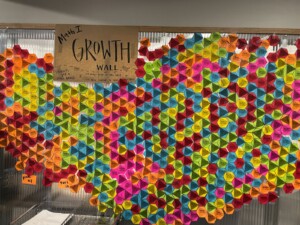From Pandemic to Possibility: Now is the Time to Consider Competency-Based Education

By: Ben Owens and Joey Lee
“The main thing is to keep the main thing the main thing.”
From the time I first read this famous Stephen Covey quote in the late 1980s, I’ve always used it as my litmus test for deciding if an initiative I was considering would be beneficial or a distraction. Its power lies not only in an objective evaluation for strategic planning, but it also forces you or your organization to really come to terms with your why.
This also explains why I believe so many educators are suggesting that now is the time to move away from the old norms of traditional grading and assessment and embrace a Competency-Based Education (CBE) approach: it better aligns with the “main thing” of true teaching and learning.
While definitions of CBE vary, there are a few core ideas that actually align it much closer to the true purpose of school than a status quo system based on arbitrary time constraints, age-based cohorts, and a fixation with grade chasing. The Aurora Institute is recognized as a leading advocate for CBE and its definition includes aspects such as the following:
- Students have individual learning pathways, with varied pacing based on progress based on evidence of mastery instead of seat time.
- Students learn actively using different schema and varied pacing based on individual needs and goals.
- Students have agency over learning decisions, including they acquire and demonstrate their learning.
- Students see assessment as a meaningful, positive, and empowering learning experience, with timely, relevant, and actionable feedback.
- Students are provided with common, rigorous expectations for learning (knowledge, skills, and dispositions) that are explicit, transparent, measurable, and transferable.
Should it have taken a global pandemic for us to realize that things like grouping and advancing students per age brackets, A-F grade chasing, and one-size-fits-all instruction is not serving all students, especially those who have historically been furthest from opportunity? No. But here we are.
The good news is that as this EdWeek article points out, educators around the country are responding to the glaring inequities of these outdated approaches by looking for better, learner-centered alternatives. Whether it’s experimenting with standards-based grading or moving to a true Competency Based Education format, more educators are using this time of massive disruption to explore more personalized ways of instruction, assessment, grading, and advancement.
The not so good news is that unlike trying a new app to improve math engagement or shifting a lesson to be more inclusive of the features of High Quality Project Based Learning, moving to a mastery, proficiency, or competency-based approach is not a trivial matter and it’s hard to do in isolation. Implementing even some elements of a CBE approach in your classroom or at a school level will require retooling your skillset and moving away from comfortable practices and systems. At the same time, such a move presents a wonderful opportunity to do some true collaborative innovation at a time when such innovation is desperately needed.
Nevertheless, schools and districts that have a disposition toward positive change, especially in a time where authentic innovation is so desperately needed, will find that a move to CBE is likely to be aligned with other learner-centered practices that are rooted in collaboration, a common purpose, and positive school culture. For example, innovative strategies that align well with a CBE approach include flexible scheduling, shifting grading from individual activities to standards, peer tutoring, alternative assessment strategies, and unique Response-to-Intervention plans. Because many of these initiatives are interrelated, schools are advised to look at them as part of a comprehensive and strategic approach to deeper, personalized student learning. CBE, therefore, provides the glue that holds these strategies together, especially when done with a commitment to collaboration across all levels of a learning community.
Competency-based education also takes a significant investment in time and planning to do well. This, unfortunately, can be seen as an overwhelming barrier to schools that might otherwise consider making the shift to CBE. Educators and administrators point out how much professional development and planning time is needed for teachers, who are typically not familiar with CBE, and how much thoughtful communication is needed for parents and other stakeholders, who may be wary of such a big change. But as hard as a CBE implementation is, schools that have done so know they will never go back – the positive impact for students, especially students who have historically struggled under an archaic system of “one & done” A-F grading.
This is the real reason CBE is getting a new look by so many schools and districts. The inequities exposed by the pandemic have forced educators to rethink what we’ve always done so that we can better meet the needs of all students, especially those who are furthest from opportunity. Under a CBE format, those students are now afforded the time they need to truly learn and master content, with targeted, just-in-time support that relies heavily on formative feedback as opposed to just-in-case, one-size-fits-all instruction. Students are also able to step off the point-chasing treadmill that focuses more on arbitrary carrots & sticks such as homework grades, extra credit, participation grades, reductions for late work, etc., and are able to focus their efforts on customized pathways based on their specific needs and goals. Finally, students are able to exercise choice and voice in how they learn and how they show what they know. Each of these characteristics speaks to how CBE offers educators a chance to move beyond the buzzwords “personalized learning” and “growth mindset” and reclaim the true meaning of terms.
You may be thinking that this is indeed the kind of environment I want in my school. But you also may be thinking that while still in the midst of a pandemic, I might not want to advocate for more change. I respectfully disagree. Borrowing from Churchill’s famous quote, “You never want a serious crisis to go to waste,” this is indeed the right time for the kind of profound disruption many education stakeholders have been calling for far too long. It provides the ideal opportunity for the kind of transformation our students deserve.
It should also be noted that in many cases, schools that had already embarked on a CBE journey were some of the ones that were able to more nimbly respond to the realities of remote learning. Laura Knapp, Alliance Manager for the Regional Education Lab Southeast, an organization coordinating a collaborative effort to expand competency-based education in North Carolina put it this way:
“When COVID-19 hit our state in the spring, it became quickly apparent to those of us working with schools and districts that the ones that had a smoother transition to virtual learning than their peers were the ones that had begun this implementation process [to competency-based education].”
The pace of change in every aspect of our world is accelerating and it’s well past the time we move from a model that was designed for a different age to one that acknowledges and celebrates students as creative individuals instead of conforming factory workers. This, above all the other reasons listed above, is why you should be taking a bold stance to demand transformative education now, including a serious look at making the leap to Competency Based Education. Will you take such a stance? Don’t be the educator who looks back at this time 5 years from now and thinks, “If I only had done more to lead the call for change when our entire education system was ripe for change.”
For more, see:
- School Superintendents Advocate for Whole Child Development
- 6 Ways School Leaders Can USe TxLX Resources for Learner-Centered Summer Programs
Joey Lee serves as Chief Learning Officer at LiFT Learning, an education organization driven to empower youth by providing innovative educators with technology and support to create learner-centered systems. In his role, Joey works to support schools and organizations implementing CBE and PBL using LiFT’s learning platform. Prior to LiFT, Joey taught at Pinkerton Academy before taking a leadership role as Director of Education at Education First. He was awarded New Hampshire’s Teacher of the Year in 2014. @JoeyLeeNHTOY
Ben Owens spent 11 years as a physics and mathematics teacher at a small, innovative public school of choice in rural Appalachia after a long career as an engineer. He now works as the co-founder of Open Way Learning, a nonprofit that helps schools create the local conditions for learner-centered innovation in their own communities. He is the co-author of Open Up, Education!. @engineerteacher
Stay in-the-know with innovations in learning by signing up for the weekly Smart Update.






Irma Gabriela Andrew
It is time to practice different ways of testing for students, the traditional method is ok but it does not help every student, we all learn differently and practicing different styles of testing will get better results for a class.